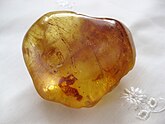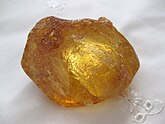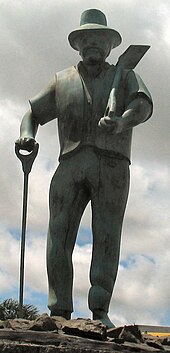Kauri gum

Kauri gum is resin from kauri trees (Agathis australis), which historically had several important industrial uses. It can also be used to make crafts such as jewellery. Kauri forests once covered much of the North Island of New Zealand, before early settlers caused the forests to retreat, causing several areas to revert to weeds, scrubs, and swamps.[1] Even afterwards, ancient kauri fields and the remaining forests continued to provide a source for the gum.[2][3] Between 1820 and 1900, over 90% of Kauri forests were logged or burnt by Europeans.[4]
Kauri gum forms when resin from kauri trees leaks out through fractures or cracks in the bark, hardening upon exposure to air. Lumps commonly fall to the ground and can be covered with soil and forest litter, eventually fossilising. Other lumps form as branches forked or trees are damaged, releasing the resin.[5]
Uses
[edit]

The Māori had many uses for the gum, which they called kapia. Fresh gum was used as a type of chewing gum (older gum was softened by soaking and mixing with juice of the puha thistle). Highly flammable, the gum was also used as a fire-starter, or bound in flax to act as a torch. Burnt and mixed with animal fat, it made a dark pigment for moko tattooing.[6] Kauri gum was also crafted into jewellery, keepsakes and small decorative items. Like amber, kauri gum sometimes includes insects and plant material.[7]
Kauri gum was used commercially in varnish, and can be considered a type of copal (the name given to resin used in such a way). Kauri gum was particularly useful for this, and from the mid-1840s was exported to London and America. Tentative exports had begun a few years earlier, for use in marine glue and as fire-kindlers;[8] gum was part of an export cargo to Australia in 1814.[9]
Since kauri gum would mix more easily with linseed oil at lower temperatures, by the 1890s 70% of all oil varnishes made in England used kauri gum.[10] It was used to a limited extent in paints during the late 19th century, and from 1910 was used extensively in manufacturing linoleum. From the 1930s, the market for gum dropped as synthetic alternatives were found, but there remained niche uses for the gum in jewellery and specialist high-grade varnish for violins.[10]
Kauri gum was Auckland's main export in the second half of the 19th century, sustaining much of the early growth of the city. Between 1850 and 1950, 450,000 tons of gum were exported.[11] The peak in the gum market was 1899, with 11,116 tons exported that year, with a value of £600,000 ($989,700 US).[9][12] The average annual export was over 5,000 tons, with the average price gained £63 ($103.91 US) per ton.[13]
Appearance
[edit]The gum varied in colour depending on the condition of the original tree. It also depended on where the gum had formed and how long it had been buried. Colours ranged from chalky-white through red-brown to black. The most prized was pale gold, as it was hard and translucent.[5][14] The size of each lump also varied greatly. Swamps tended to yield the small nuggets known as "chips", whereas hillsides tended to produce larger lumps. The majority were the size of acorns, although some were found which weighed a few pounds. The largest (and rarest) were reported to weigh half a hundredweight.[15] Kauri gum shares a few characteristics with amber, another fossilised resin found in the Northern Hemisphere. While amber can be millions of years old, carbon-dating suggests the age of most kauri gum is a few thousand years.[8]
Gumfields
[edit]
Most of the gumfields were in Northland, Coromandel and Auckland, the site of the original kauri forests. Initially, the gum was readily accessible, commonly found lying on the ground. Captain Cook reported the presence of resinous lumps on the beach at Mercury Bay, Coromandel, in 1769, although he suspected it came from the mangroves, and missionary Samuel Marsden spoke of their presence in Northland in 1819.[14]
By 1850, most of the surface gum had been harvested, and people began digging for it. The hillsides yielded shallow-buried gum (about 1 m), but in swamps and beaches it was buried much deeper (4 m or below).[2]
Gum-diggers
[edit]
Gum-diggers were men and women who dug for kauri gum in the old kauri fields of New Zealand at the end of the 19th and early 20th centuries. The term may be a source for the nickname "Digger" given to New Zealand soldiers in World War I.[16] In 1898, a gum-digger described "the life of a gum-digger" as "wretched, and one of the last [occupations] a man would take to."[17]
Gum-diggers worked in the old kauri fields, most of which were then covered by swamp or scrub, digging for gum. Much of the population was transient, moving from field to field, and they lived in rough huts or tents (which were called "whares", after the Maori for 'house'). It was extremely hard work and not well paid, but it attracted many Maori and European settlers, including women and children.[18] There were many Dalmatians, who had first come to work the South Island goldfields in the 1860s.[19] They were transient workers, rather than settlers, and much of their income was sent out of the country, resulting in resentment from the local workforce. In 1898, the "Kauri Gum Industry Act" was passed, which reserved gum-grounds for British subjects, and requiring all other diggers to be licensed. By 1910, only British subjects could hold gum-digging licences.[20]
Gum-digging was the major source of income for settlers in Northland, and farmers often worked the gumfields in the winter months to subsidise the poor income from their unbroken land. By the 1890s, 20,000 people were engaged in gum-digging, of which 7000 worked full-time.[21] Gum-digging was not restricted to settlers or workers in the rural areas; Auckland families would cross the Waitematā Harbour by ferry at weekends to dig in the fields around Birkenhead, causing damage to public roads and private farms, and leading to local council management of the problem.[22]
Methods
[edit]

Most gum was dug from the ground using gum-spears (pointed rods to probe for gum) and "skeltons", defined as blade-edged spades for cutting through old wood and roots as well as soil. Once the gum was retrieved it would need to be scraped and cleaned.[23]
Digging in swamps was more complicated. A longer spear (up to 8m) was often used, often fitted with a hooked end to scoop out the lumps. Scrub was often cleared first with fire; some became uncontrolled and swamp fires could burn for weeks.[24] Holes were often dug by teams in both hills and swamps—often up to 12m deep—and some wetlands were drained to aid in the excavation of gum.[25] As field gum became scarce, "bush gum" was obtained by purposely cutting the bark of kauri trees and returning months later to retrieve the hardened resin. Due to the damage caused to the trees by the cutting the practice was banned in state forests in 1905.[23] Gum chips, small lumps useful for the manufacture of linoleum, were difficult to find. By 1910, the process of washing and sieving to retrieve the chips became common. The process was later mechanised.[26]
Gum merchants
[edit]Gumdiggers generally sold their gum to local gumbuyers, who transported it to Auckland (generally by sea) for sale to merchants and exporters.[27] There were six major export firms in Auckland who dealt in gum, employing several hundred workers who graded and rescraped the gum for export, packing them in cases made from kauri timber.[28]
As early as the 1830s and 1840s, merchants, including Gilbert Mair and Logan Campbell, were buying gum from local Māori for £5 ($8.25) a ton or trading it for goods.[9] The majority of the gum was exported to America and London (from whence it was distributed throughout Europe), although smaller amounts were sent to Australia, Hong Kong, Japan and Russia.[29]
See also
[edit]Notes
[edit]- ^ Taonga, New Zealand Ministry for Culture and Heritage Te Manatu. "How and where kauri grows". teara.govt.nz. Retrieved 30 January 2023.
- ^ a b Hayward, pp 4–5
- ^ "Te Ara Encyclopedia of NZ: Kauri Forest". Teara.govt.nz. 1 March 2009. Retrieved 25 April 2011.
- ^ "In the forests of New Zealand, indigenous Maori and Western scientists work through past injustices to save a threatened species together". Ensia. Retrieved 30 January 2023.
- ^ a b Hayward, p 2
- ^ Hayward, p 3
- ^ "Category: kauri". Collections Online. Museum of New Zealand Te Papa Tongarewa. Retrieved 18 July 2010.
- ^ a b Gilbert Mair, 1843–1923 (1 March 2009). "Te Ara: The Encyclopedia of New Zealand: Origins and uses". Teara.govt.nz. Retrieved 25 April 2011.
{{cite web}}: CS1 maint: numeric names: authors list (link) - ^ a b c Hayward, p 46
- ^ a b Hayward, p 45
- ^ "Te Ara Encyclopedia of NZ: The Industry". Teara.govt.nz. 2 March 2009. Retrieved 25 April 2011.
- ^ Dunmore, p 21
- ^ Reed, p 114
- ^ a b "Encyclopedia of NZ, 1966: Kauri Gum". Teara.govt.nz. 22 April 2009. Retrieved 25 April 2011.
- ^ Reed, p 20
- ^ Te Ara: The Encyclopedia of New Zealand: The New Zealanders
- ^ recorded in Appendices to the Journals of the House of Representatives, 1898, H–12, p. 31, and quoted in Te Ara Encyclopedia of NZ
- ^ Te Ara: The Encyclopedia of New Zealand: Gumdigging
- ^ Te Ara Encyclopedia of NZ: Damaltians
- ^ Te Ara Encyclopedia of NZ: Dalmatians: Gumdiggers
- ^ Hayward, p 47
- ^ McClure, p 55-6
- ^ a b Te Are Encyclopedia of New Zealand: Gumdigging methods
- ^ Hayward, pp 10–11
- ^ Hayward, pp 12–13
- ^ Hayward, p 27
- ^ Hayward, p 19
- ^ Hayward, pp 42–43
- ^ Hayward, p 44
References
[edit]- Hayward, Bruce W (1982). Kauri Gum and the Gumdiggers: A Pictorial History of the Kauri Gum Industry in New Zealand. Auckland: Lodestar Press. ISBN 0-86465-014-0
- McClure, Margaret (1987). The Story of Birkenhead. Auckland: Birkenhead City Council. ISBN 0-908704-04-6
- Reed, Alfred (1972). The Gumdiggers: The Story of Kauri Gum. Auckland: A.H. & A.W. Reed. ISBN 0-589-00732-7
- Dunmore, Patricia (ed.) (1977). The Dunmore Book of New Zealand Records. Wellington: Dunmore Press. ISBN 0-908564-08-2
External links
[edit]- Te Ara, The Encyclopedia of New Zealand
- Digger History
- The Kauri Museum Archived 15 December 2007 at the Wayback Machine
